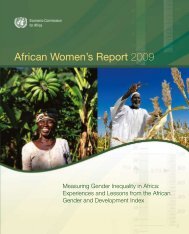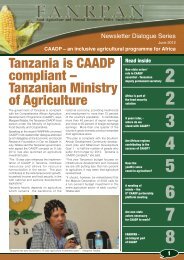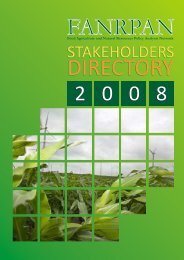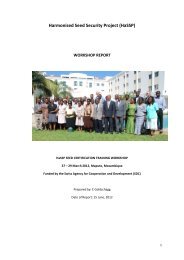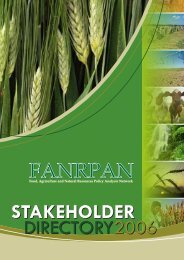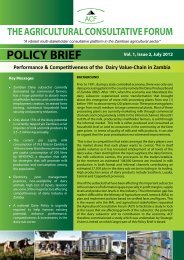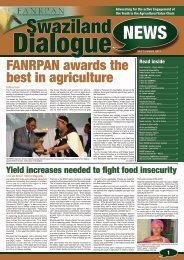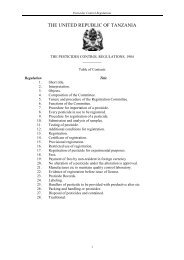Community-driven development decision tools for rural - IFAD
Community-driven development decision tools for rural - IFAD
Community-driven development decision tools for rural - IFAD
- No tags were found...
Create successful ePaper yourself
Turn your PDF publications into a flip-book with our unique Google optimized e-Paper software.
To link community <strong>development</strong> and technological innovation, community project designers andmanagers must design and implement adaptive research to facilitate adoption of the innovation bythe target group. Clear thinking, strong determination and the right incentives are required to designand implement research programmes in close association with the ultimate users. A programmeshould concentrate on how to solve problems that challenge farmers in handling their productionschedule and on how to adapt native products and innovative products developed elsewhere to thefarmers’ land and its resources.To respond to these problems, a strong ef<strong>for</strong>t has been made to discuss and rationalizeadapting design technology and participatory research, particularly to reach a specific target groupof farmers. <strong>IFAD</strong>’s contribution to this ef<strong>for</strong>t includes funding <strong>for</strong> an exhaustive, three-volumepublication entitled “Participatory Research and Development <strong>for</strong> Sustainable Agriculture andNatural Resource Management”, 22 which the reader is strongly advised to consult. Some of thebasic questions the document addresses include “Who participates? How? Who decides? Whobenefits? Who wins and who loses?”. It points out “the complex sociocultural, economic, andpolitical context of research workers” and “that research and <strong>development</strong> strategies designedtogether with communities enable a more nuanced understanding of the issues and a transparencythat may facilitate change” 23Governments and financing agencies are perfectly entitled to focus on research that willgenerate increases in land productivity regardless of whom it benefits. However, most cases aredependent upon specific producers’ potential (e.g. as a result of location, availability of irrigationor good rainfall and fertile land). In such cases, it is important to clarify that the researchobjectives may be unrelated to improving the livelihood of <strong>rural</strong> communities, particularly ofthose that operate in marginal areas. If this point is clarified, it is easier to see that there is also theneed to fund research activities aimed at improving the production of a target group which is notoperating in the good potential areas of a country and which has problems of survival and growth.Demand-<strong>driven</strong> vs. project-led activitiesRural <strong>development</strong> projects always include activities that are project-led and activities that can bedemand-<strong>driven</strong>. Activities that are predominantly project-led include institutional <strong>development</strong>(i.e. setting the rules of the game), in<strong>for</strong>mation and communication, mobilization of people’sdemand, capacity-building, gender sensitization, scientific research <strong>for</strong> technology generation andtransfer of resources (e.g. funds, goods, technical assistance) from outside the communities. Theword “predominantly” is used intentionally, since the CDD content of a project varies to theextent that there is proactive input by the communities in those activities. For example, CDDcontent is higher if rules are established in consultation with the communities, if communicationis a two-way process that improves the capacity of both citizens and the public administration tocommunicate with one another and if technology generation results from a close dialoguebetween research outfits and farmers.CDD requires mechanisms to bring about a proactive encounter of project-led and demand<strong>driven</strong>activities. (For example, a certain project includes a women’s capacity-building subcomponent.Be<strong>for</strong>e deciding on how to implement this sub-component, the PCU discusses withthe women which capacity-building activities are most important <strong>for</strong> them, offering them a widerange of open-ended options. The women select functional literacy training and ask that thetraining be held in the evening, after dinner. The PCU proceeds to implement the subcomponentaccording to the women’s choice and needs.) Predominantly demand-<strong>driven</strong>22 Volume 1: Understanding Participatory Research and Development, Volume 2: Enabling Participatory research and Development,and Volume 3: Doing Participatory Research and Development. The book is the product of a number of authors coordinated bythe International Potato Center - Users’ Perspectives with Agricultural Research and Development (CIP-UPWARD) and <strong>IFAD</strong>.23 “Participatory research …”, volume 1, page 55.47




